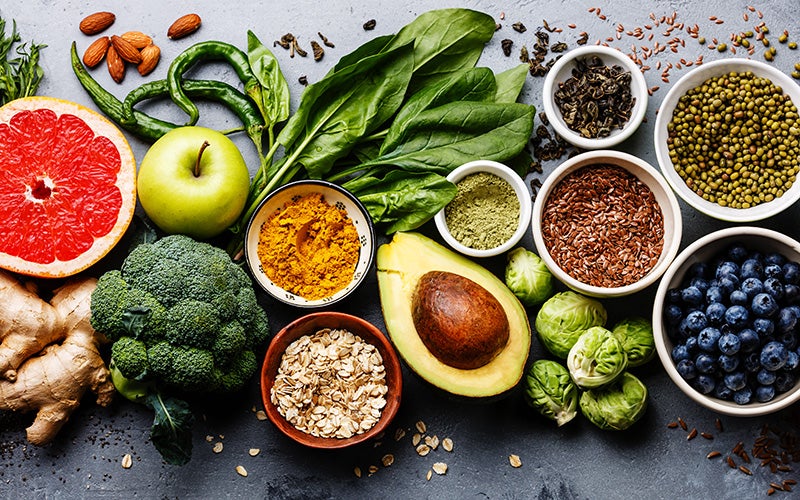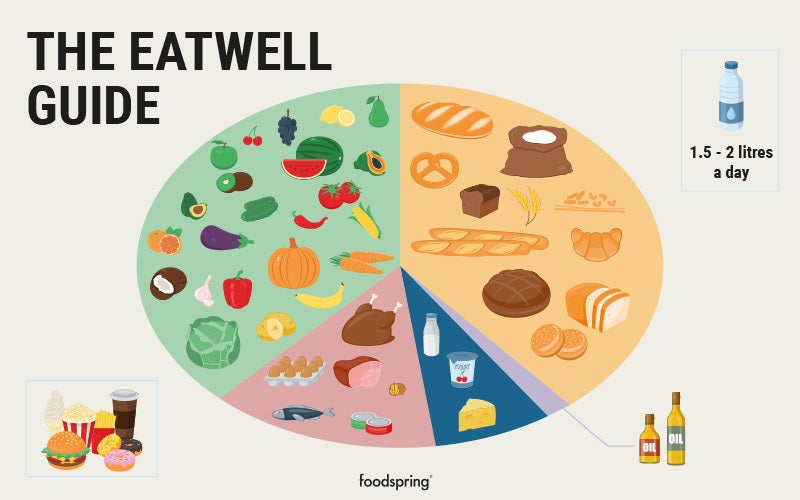Food Pyramids: Explanation, use, and models
 ©Lisovskaya
©Lisovskaya
Food pyramids and plates
Sometimes find it difficult to keep track of what foods you should be eating in the jungle of nutrition information? What’s healthy eating? How much should I eat, and of what food? Which healthy foods are packed with which nutrients? All the information coming at us through various platforms makes it pretty difficult to figure out what food is really part of a healthy and balanced diet.
Thankfully, models like food pyramids and plates make it easier because they turn the basic rules into visual overviews. We’ve done the research on different models and explain what foods each guide says you need to pay attention to.
Looking for personalized nutrition tips and product recommendations? Our Body Check will tell you everything you need to know – adapted to your BMI and your personal goals.
start your free Body Check now
The AID food pyramid
The AID food pyramid was designed by AID, the German agency for consumer information. This food pyramid is a useful basis for healthy eating because it clearly shows1:
- What foods you should eat the most of (green), in moderation (yellow) and sparingly (red)
- How many servings you should eat of what food
- Which foods you should eat

How many servings is that?
One of the advantages of the aid food pyramid is that it’s also easy to figure out quantities for healthy eating because each group in the food pyramid has a number of servings assigned to it. For example, you should eat 3 servings from the vegetable food group and 2 servings from the fruit food group every day.
In summary:
- A small serving of treats
- 2 servings of oils & fats
- 3 servings of milk or dairy products, plus a serving of meat or similar
- 4 servings of grains & cereals
- 5 servings of fruit & vegetables
- 6 servings of drinks

A food pyramid for children
One of the other advantages of this food pyramid is its versatility as a healthy eating guide – it works for both adults and children. If you use the palm of your hand as a way to judge serving size for many foods, the amount of food you should be eating increases as you grow, but the ratios you see in the food pyramid stay the same.
The Eatwell guide model
The pyramid concept has been shaped into a plate in the UK – and the US as well. This model, now called the Eatwell Guide in the UK, shows how much of which food group you should eat through how much space it should take up on your plate.
The Eatwell plate
According to the Eatwell Guide, healthy eating means balancing your choices from five food groups over the day or week2:
1/3 fruits and vegetables
1/3 grains and starches
The final 1/3 is divided up between dairy products, proteins, and fats, from both animal and plant sources.

Now let’s go into a bit more detail on each of the Eatwell Guide’s food groups:
- Fruits and vegetables
- Grains and starches
- Legumes, fish, eggs, meat, and other proteins
- Dairy and alternatives
- Oils and spreads

©fcafotodigital
Vegan food pyramid
Veganism as a lifestyle is becoming more than just a healthy eating trend, so a guide for balanced vegan nutrition is more important than ever. The University of Giessen created a version of the food pyramid to guide vegans with an overview of all the foods and dietary requirements they need to keep up their health.
This model is based on a 14-day vegan healthy eating plan3. It’s particularly important for vegans to pay attention to the following nutrients:
- Protein
- Long-chain omega-3 fatty acids
- Vitamin D
- Riboflavin
- Vitamin B12
- Calcium
- Iron
- Zinc
- Iodine
- Selenium

The following recommendations are based on a 14-day nutrition plan:
Drinks
Drinks form this pyramid’s foundation. You should drink at least 1.5 liters a day, mostly water and other non-alcoholic and low-calorie drinks.
Vegetables
Plenty of fresh, crisp vegetables should be part of all healthy eating plans. In this guide, the recommendation is at least 3 servings or 400g per day. The Giessener food pyramid includes 1-3g of seaweed per day as a nutrition supplement. If this isn’t practical for you, an iodine supplement will also help you stay healthy.
Fruit
“An apple a day keeps the doctor away.” Of course, a large amount of fruit is also included in this guide. Keep up your health with 2 servings or 250g of fruit a day.
Whole-grain products and potatoes
Let’s break this group down into more detailed list of which foods you should eat and their respective serving sizes:
4 servings a day; per serving:
– grains and rice: approx. 60-75g (raw)
– wholegrain bread: 2-3 slices of 50g each
– wholegrain pasta: 125-150g
– potatoes: 2-3, medium size (approx. 200-350g)
Legumes and other sources of protein
Since a vegan diet doesn’t include any animal products, you have to make sure that you get enough alternative sources of protein. Legumes are particularly good sources of protein and are 40-50g (raw) per serving. Tofu, tempeh, seitan, and lupine products (no more than 50-100g) are also helpful in a vegan nutrition plan.
Dairy alternatives
The pyramid recommends 1-3 servings a day, with an emphasis on unsweetened varieties. One serving is approximately 100-200g of soy milk or other milk or yogurt alternative.
Nuts and seeds (includes nut butters)
Nuts are the ultimate in healthy eating for a vegan diet. The Giessener food pyramid recommends 1-2 servings (30g per serving) a day.
Vegetable oils and fats
Oils and fats should always be consumed in small quantities, so no more than 2 servings (2-3 tablespoons) daily. 1 tablespoon should be linseed oil because it’s particularly rich in omega-3 fatty acids.
Miscellaneous
Certain nutritional requirements cannot be met with purely plant-based foods and must be covered with supplements:
– Daily: Vitamin B12
– Iodized table salt or sea salt enriched with iodine-rich algae
– Go outside to help your body produce Vitamin D (take Vitamin D supplements during the low-sun months between October and March)

Our conclusion
A food pyramid or plate is a good foundation for a better understanding of a balanced diet. Although these different food models have slight variations, in essence they’re pretty similar in their approach to healthy eating. As a rule of thumb, remember the foundation is always that you get enough liquids in the form of water or unsweetened drinks. This is followed by vegetables and fruit in plentiful quantities: you can eat as many vegetables as you like, because we tend to eat fruit that’s somewhat acidic and vegetables that are basic, but to a lesser extent. Consume animal products in moderation, the same goes for unhealthy foods. The food pyramid for vegan diets takes essential nutrients such as Vitamin B12 into account.
Sources for this article
We at foodspring use only high-quality sources, including peer-reviewed studies, to support the facts within our articles. Read our editorial policy to learn more about how we fact-check and keep our content accurate, reliable, and trustworthy.
- Bundeszentrum für Ernährung (German Ministry of Nutrition): www.bzfe.de/inhalt/die-aid-ernaehrungspyramide-640.html
- NHS -The Eatwell Guide (01/2019, accessed 05/2020): https://www.nhs.uk/live-well/eat-well/the-eatwell-guide/
- Ernährungsumschau (08/2018): The Gießener vegan food pyramid, pp. 134-143

































